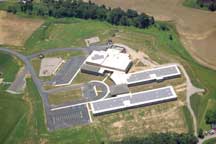By Toby MacDermott
North Adams Elementary is one of the greenest schools in southeast Ohio. With solar panels on the roof, wild turkeys roaming the grounds, and a design based on LEED, or Leadership in Energy and Environmental Design, standards, this school exemplifies sustainability in action. But this building is not alone. The entire Adams County/Ohio Valley school district has gone green. With solar panels on several school buildings, and the school board’s pursuit of energy efficiency helping the their bottom line, the students get a real world education in the benefits of going green.
All this has taken place in the past five years, without a large out-of-pocket expense. Located in the Ohio Valley, this rural, somewhat impoverished area has one of the highest unemployment rates in the state. Despite these hurdles, the school district has transformed itself into “one of the greener districts around here,” according to Facilities Manager Steve Wolfe.
Through a partnership with the Ohio School Facilities Commission, Adams County schools were able to fund several new schools for seven cents on the dollar. Geothermal heating and cooling systems at several new schools were installed as part of the district’s energy conservation strategy. Similarly, solar panels were installed on the roof through a partnership with Kastle Solar LLC.
They own and installed the panels at no cost to the district, allowing the school to buy electricity at a greatly reduced rate when the sun is out.
Similarly, by going through older schools with a fine-toothed comb to improve efficiency, the school district was able to save quite a bit of money. Through another partnership, they were able to replace old inefficient bulbs with modern low-energy bulbs.

By improving efficiency and switching to renewable power sources such as solar panels and geothermal heating and cooling, the Adams County/Ohio Valley school district saved over $100,000 in utility costs at three older high schools. Photo courtesy of Kastle Solar LLC
“Twelve months later we had shaved over $100,000 off the utilities [at three older high schools],” says Wolfe.
With all these solar panels and savings from efficiency, the schools have been able to share the learning experience with their students. A website shows the energy production from the solar panels in real time, so that the students can see when the lights and computers in their classrooms are running off the sun.
With the children learning these valuable lessons at school, the entire community sees the benefits. Jim McClanahan, energy manager for Scott County Schools in Kentucky, took a different approach to keeping the lights off. Rather than spending money on occupancy sensing switches to turn off the lights when the room is empty, he empowered the students. Now they have Student Energy Teams that turn off unused lights and remind others to do the same, helping to change the culture of the schools. The students take this education home, spreading the benefits from school into the community.
In Adams County, Ohio, Wolfe’s search for energy inefficiencies in their old schools led them to the biggest energy user in the building, the HVAC system. Rather than buying new, Wolfe’s team went through the existing system and made sure that everything was running smoothly, then took a close look at how they used it. Instead of heating or cooling the building in case someone needs to use it, now there is a reservation system. If someone needs to use the building after hours, a quick reservation is all they need to do, otherwise the system turns off when the school day ends.
Similarly, the classroom temperature is now limited to a couple of degrees up or down. No longer could “people get their rooms like a freezer, or like a sauna,” says Wolfe. Changing the way that the HVAC system runs was one of their most effective energy saving measures.
In order to upgrade the lighting systems, the school district looked at rebates and incentives offered by their local electric utility. With very little cash outlay, they replaced the metal halide bulbs in the schools’ gyms with much more efficient fluorescent bulbs.
Once educators began to see the benefits of having more efficient systems, they also began to envision new ways to teach their students. Efficiency and energy savings tie right into teaching children about basic science and economics. Continuing their environmental stewardship work, the school board has recently begun a robust recycling program for the district: A new solar-powered recycling compactor lets students see the power of the sun in action, and saves transportation costs by reducing the amount of recycling truck traffic.
With all the economic, educational and environmental benefits of green building and energy efficiency, Wolfe says,”It’s win, win, win all the way around.”
Related Articles
Latest News
More Stories

Leave a comment
Your email address will not be published. Required fields are marked *
3 responses to “Two School Districts Go Green to Save Green”
-
Hi Gary,
I don’t have any information on what funding mechanisms these schools used, but would suggest reaching out to Steve Wolfe with the Ohio School Facilities Commission or with Jim McClanahan at Scott County Schools in Kentucky. Good luck! -
Thanks! In advance.
-
Please send me to a particular website, or if possible please send me the grant opportunity that you guys may have utilized to become as “Green” as you are>
Thanks!
I am an administrator with the Calcasieu Parish School Board (Lake Charles, LA), seeking information on how an entire school system can go green and save money.
Thanks!





Leave a Comment